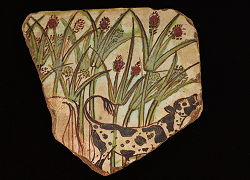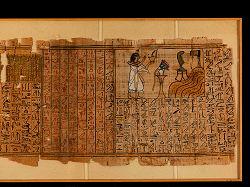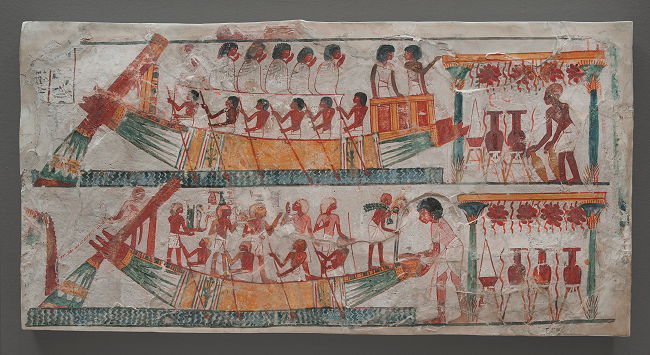In Ancient Egypt, draughtsmen and painters were known as ‘contour scribes’. Indeed, Egyptian art was primarily determined by lines encompassing forms and areas, thereby producing outline sketches within which colours in all their hues could be applied to dazzling effect.
 Covering tile: a cow or a calf in the marshes
. Egyptian tile.
New Kingdom, 18th dynasty, reign of Akhenaton, XIVth century B.C.
Probably Tell-el-Amarna
. Paris, Musée du Louvre, Department of Egyptian antiquities, inventory E17357
© Musée du Louvre/Christian Décamps
The exhibition, which, as ‘The Art of Outline Drawing in Ancient Egypt’, had its first showing at the Louvre in Paris (from April to July 2013), points up the importance of drawing in the pharaonic civilization. It treats conventions, techniques, functions and applications, and brings the visitor into direct contact with Egyptian artists through the medium of the most free and spontaneous creations, as well as of strictly official works of art. A whole range of questions regarding the ‘contour scribes’ are dealt with, including: how and by whom they were trained, what their position in society was, how much literary and artistic schooling they had, and how their creativity and aesthetic sense can be described.
Specific codes
Very early, as of the end of the IVth millennium, ancient Egypt perfected the way it represented its universe in two dimensions. Its artists would maintain these codes for over three millennia, and used them in their royal propaganda, in religion and magic, in order to ensure the stability and sustainability of the subjects they worked on. Egyptian artists do not represent a scene such as the human eye sees it but rather they offer an image – or images – of a world of concepts. Consequently, each element of a whole is brought down to its most simple aspect, and this breaks down the painting, and creates a multitude of points of view. This technique of aspectivity – as it came to be named - applies for example to the drawing of a face in which the eye looks forward and the nose is seen in profile.
 Book of the Dead of Khonsoumès
. Papyrus, black and red inks, paint highlights
. Third intermediary period, 21st dynasty, 1069-945 B.C.
Origin unknown (probably Deir-el-Bahari ( ?); purchase, 1826
. Paris, Musée du Louvre, Department of Egyptian antiquities, inventory N3070
© Musée du Louvre/Christian Décamps
The exhibition also seeks to provide a profound reflection on the concept ‘art’ in Ancient Egypt, as well as to consider how we ourselves experience Egyptian art, what ideal of beauty lies behind that art, and how that relates to the function of the works of art produced by the artists of the Nile Valley. This rich range of themes is explored on the basis of approximately 200 remarkable items lent by world-class museums, and includes illustrated papyri and ostraka, wall paintings from tombs, stelae, sculptures, items of grave furniture, and drawing instruments. Numerous of these items have come from the Louvre and the Royal Museums of Art and History, and also co-operating in the exhibition are major institutions like the Metropolitan Museum of Art (New York), the British Museum (London), the Ägyptisches Museum (Berlin), the Museo Egizio (Turin) and the Musée des Antiquités nationales (Saint-Germain-en-Laye).
PUBLICATION:
• Catalogue : L’art du contour – Le dessin dans l’Égypte ancienne, under the direction of Guillemette Andreu-Lanoë, Louvre Éditions / Somogy éditions d’art, 2013, €39.
To see more illustrations, click on VERSION FRANCAISE at the top of this page
|










